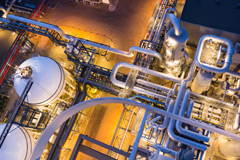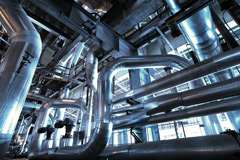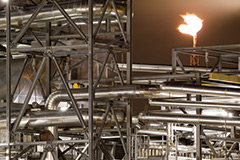
Blue Line
707 105 555
Chemistry and Petrochemicals
GASES USED
Nitrogen / Carbon Dioxide / Hydrogen / Oxygen

HYDROGENATION
Hydrotreating removes many contaminants from the oil, with Hydrogen being an essential reagent in this process. Hydrogen can break down heavy oil molecules into lighter (cracked) fuels and higher commercial value, and in addition to improving fuel quality and octane, it also reduces environmental contamination.

ENRICHMENT WITH OXYGEN
Using oxygen to enrich the atmosphere of the catalytic cracking unit is a more cost-effective option and the advantages are: increasing the capacity of the regenerator, increasing the conversion of the process to a given feed, easier handling when there is more formation of Coke and easier to handle changes in feed composition.
IN THE CLAUS PROCESS
Most of the gas coming from refineries, natural gas and gasification process units, in addition to other compounds, contain sulfuric acid (H2S), having to be treated in sulfur recovery units. The application of oxygen in the enrichment of the CLAUS process allows an increase in production by increasing the process capacity, increasing the sulfur content in the process loading and environmental reasons.

PURGE
Nitrogen, being an inert gas, can displace flammable gases from a container, reducing the risk of oxidation, fire or explosion. Oxygen and moisture can be removed from the reactors. The filling / emptying process of the Nitrogen reactor is fully controllable. The risk of fire and / or explosion is eliminated as there is no use of pumps. In addition, the use of Nitrogen ensures that no reaction will occur, either with the substance stored or stored.

TRANSFER BY PRESSURE
Nitrogen is used as propellant and protector in the closed transport system in the process of transfer of the product by the pressure between two containers, without the need to pump, in a practical way. Thus, the costs of electricity are reduced, with protection of the substance to be transferred.

BLANKETING
After purging, in order to protect the purity of the product and avoid the risk of explosion, it is necessary to keep the combustible product isolated from atmospheric oxygen. For this, an inert and uniform atmosphere above the combustible substance must be maintained by adding Nitrogen while the tank is being refilled or emptied. The moist air present in the empty space of the tank is replaced by high purity Nitrogen.

INERTIZATION
Ineration is achieved by the use of an inert gas, such as Nitrogen, which forms a protective layer, preventing reaction of the products. The release of flammable gases in the petroleum refining process requires the use of a non-reactive gas to eliminate the risk of combustion.

DRYING
In potential oxidation or corrosion problems, Nitrogen is used for drying operations, replacing hot air.

QUALITY AND ENVIRONMENTAL CONTROL PROCESSES
Petroleum refineries, chemical and petrochemical industries use a range of pure gases and special gas mixtures, in the control of the combustion process, in the regular calibration of the use of analyzers that require rigorous standards, in the monitoring of Oxygen, Carbon Dioxide and carbon monoxide and in explosion limit alarms and leak detectors.